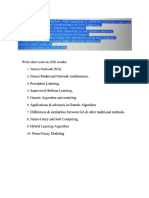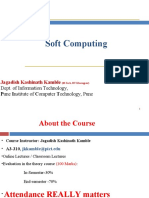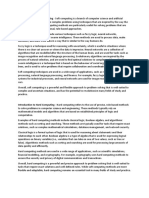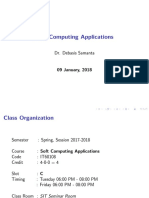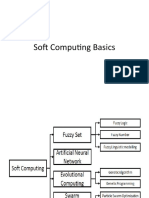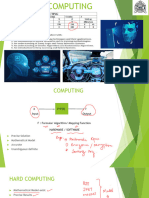Soft Computing Notes
1. Soft Computing - Soft computing is a way of solving real-world problems where things are
uncertain, incomplete, or not exact. - Instead of searching for perfect answers, it focuses on 'good
enough' solutions, similar to how humans make decisions. - Main methods: Neural Networks, Fuzzy
Logic, Genetic Algorithms.
2. Artificial Neural Networks (ANNs) - What they are: Computer models inspired by the human
brain. - How they work: Learn from examples instead of fixed rules (e.g., learning to identify
cats/dogs from many pictures). - Strengths: Good at pattern recognition, predictions, and handling
complex data. - Applications: Image recognition, speech recognition, medical diagnosis, stock price
prediction.
3. Fuzzy Logic - What it is: A way of reasoning that allows partial truth (not just yes/no). - How it
works: Instead of only true/false, it uses values like 'a little hot,' 'medium hot,' 'very hot.' -
Applications: Washing machines, air conditioners, traffic control, automatic systems.
4. Genetic Algorithms (GAs) - What they are: Problem-solving methods inspired by evolution and
natural selection. - How they work: 1. Start with random solutions. 2. Choose the best ones
(selection). 3. Mix them (crossover). 4. Make small random changes (mutation). 5. Repeat to get
better solutions each generation. - Applications: Route planning, scheduling, optimization, puzzle
solving, design problems.
5. Hybrid Systems - What they are: Combinations of different soft computing techniques for
stronger results. - Examples: - Neuro-Fuzzy: Neural networks (learning) + fuzzy logic (reasoning). -
Neuro-Genetic: Genetic algorithms used to optimize neural networks. - Fuzzy-Genetic: Genetic
algorithms improve fuzzy rules. - Why use them: They combine strengths of multiple methods to
solve harder problems effectively.
Summary - Soft Computing = flexible, human-like problem-solving. - Neural Networks = brain-like
learning from examples. - Fuzzy Logic = reasoning with shades of truth. - Genetic Algorithms =
evolution-inspired optimization. - Hybrid Systems = teamwork of methods for smarter solutions.











